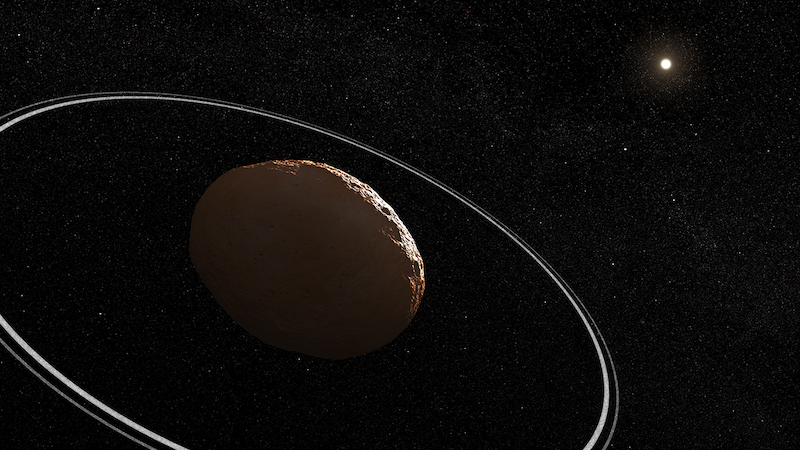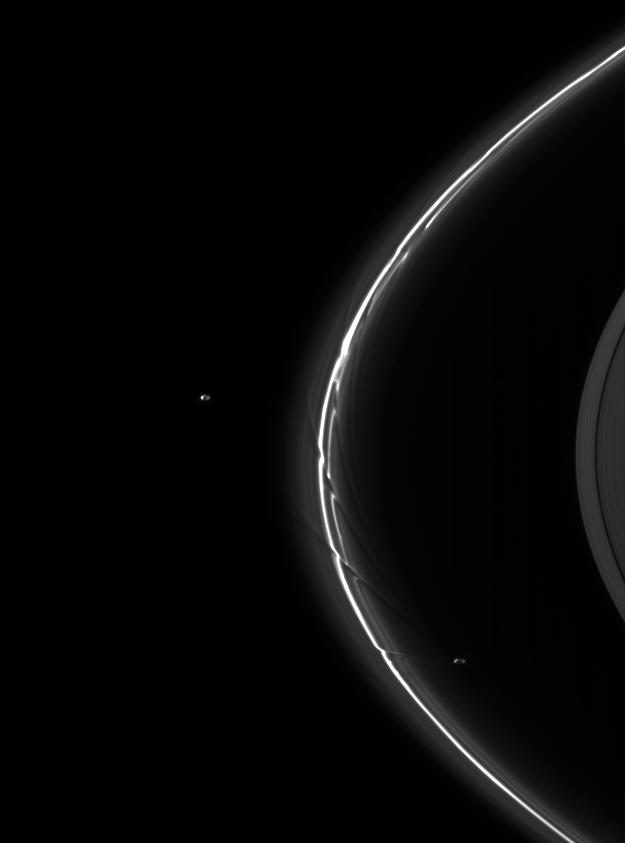
- Little asteroid-like Chariklo – which orbits the sun between Saturn and Uranus – was discovered in 2013 to have two thin rings.
- Now researchers have proposed the existence of a tiny, unseen moon orbiting Chariklo, which might help maintain and shape the rings.
- The scientists used N-body computer simulations to model the dynamics of Chariklo’s rings. The simulations suggested a satellite about two miles in radius, too small to be seen in earthly telescopes.
Chariklo is a tiny world, less than 200 miles (320 km) across). It’s like an asteroid, but orbits between Saturn and Uranus. That makes it one of some 500 known centaurs in our solar system. Rocky little Chariklo sports two thin rings, only a few miles in width, discovered in 2013. And, since then, scientists have puzzled over how the rings might have formed and how they are maintained around Chariklo. On February 6, 2024, researchers at the Planetary Science Institute in Tucson, Arizona, and Trinity University in San Antonio, Texas, suggested an answer. They suspect a tiny unseen moon of Chariklo.
The researchers published their peer-reviewed findings in The Planetary Science Journal on February 6, 2024.
Chariklo’s rings are a recent discovery
Previously, we only knew the gas giant planets in our solar system had ring systems. Saturn’s ring system has been glimpsed through telescopes since the 1600s. And, in the 1970s and ’80s, the Voyager spacecraft spotted rings for Jupiter and Neptune. And astronomers found rings for Uranus, too, in 1977, when the rings temporarily blotted out the light of a star. So all four gas giant worlds in our solar system are known to have rings. But Chariko?
Astronomers were surprised when they first spotted Chariklo’s rings in 2013. After all, Chariklo is only about 188 miles (302 km) in diameter. Astronomers know of only a few other smaller bodies that have rings. Dwarf planet Haumea, way out past Neptune, appears to have a single ring. And the centaur Chiron has ring mimics.
But how do small asteroid-sized bodies – like Chariklo – develop rings and maintain them? As lead author Amanda Sickafoose at the Planetary Science Institute stated:
We’ve only recently discovered rings around minor planets, and we only know of a small number of such systems. There has been significant research into the dazzling rings around the giant planets; however, the mechanisms of ring formation and evolution around small objects are not well understood. We’ve shown that one of the possibilities for thin rings to exist around small bodies is that they are being sculpted by a small satellite.
Simulating Chariklo’s rings
The researchers created N-body computer simulations of Chariklo’s ring system. These N-body simulations – first developed to study Saturn’s rings – model the physical dynamics of the ring system for a various number (N) of components. This provides clues as to how a ring system formed and evolved.
Just like Saturn’s rings, Chariklo’s rings are composed of millions of particles. Scientists say they are likely composed of water ice. By modeling those millions of ring particles, the researchers determined that a single tiny moon could help maintain them. This is similar to how the tiny “shepherd” moons Pandora and Prometheus maintain and shape Saturn’s thin F ring. The paper stated:
The discovery of two thin rings around the centaur Chariklo was the first of its kind, and their formation and evolutionary mechanisms are not well understood. Here, we explore a single shepherd satellite as a mechanism to confine Chariklo’s rings.
Sickafoose said they’ll need more simulations to fully understand the rings’ characteristics:
We think that the ring particles are primarily made of water ice, like those at the giant planets. We do not know the exact characteristics, such as how “hard” or “soft” the ring particles are when they collide, or the particle-size distribution. Further simulations can help constrain those properties.
Why are the rings not dispersing?
Typically, ring systems will spread out and disperse if not gravitationally held in place. But Chariklo’s rings are staying in place. How? Sickafoose continued:
Planetary rings will naturally spread or disperse over time. Chariklo exhibits two thin rings, a few kilometers in width. In order for the rings to stay this thin, there needs to be a mechanism to confine the material and prevent it from dispersing. We actually show this in the paper by simulating a Chariklo-like ring system that does not have a satellite, and we find that the width of the rings increases linearly with time. This is unlike the situation when there is a satellite in resonance with the ring material, which acts to confine the rings into the kilometer-sized widths that we observed.

Shepherding moon is too small to see
If there is a small shepherding moon, then it’s too small to see with current telescopes, as Sickafoose noted:
Our paper shows that Chariklo-like rings can be constrained by a small satellite, one that is roughly 2 miles (3 km) in radius and 22 trillion pounds (10 trillion kg) in mass. A satellite this size is below our current direct-imaging limits, so indirect methods or a spacecraft mission would be needed to discover it. An alternate mechanism that has been proposed is that Chariklo has a gravitational anomaly on its surface and the rings are in resonance with the spin of the nucleus; for every three rotations by Chariklo, the rings orbit once. The physics that act on the ring particles are similar for both a satellite or a spin-orbit resonance with a gravitational anomaly.
Near the Roche limit
Another interesting aspect of Chariklo’s rings is that they are close to the Roche limit. Inside the Roche limit, the gravitational forces of the parent body should shred material to form a ring. But outside the Roche limit, the material should create moons instead. A shepherd moon could cause the material to remain as rings instead of coalescing into a moon. As Sickafoose explained:
Interestingly, by most reasonable assumptions, Chariklo’s rings are also located near or outside of the Roche limit. The Roche limit is the rough distance beyond which rings should not exist because the material should start accreting into moons. At this distance, the gravitational perturbation from the parent planet is insufficient to shear the particles, and they can form into larger clumps. A satellite in this situation can perturb the ring material and prevent it from accreting, similar to what is seen in Saturn’s F ring.
Early last year, NASA’s Webb space telescope observed Chariklo’s rings. Webb did this by looking at Chariklo during a stellar occultation. That’s when it passed in front of a distant star from Earth’s point of view. Webb saw the star blink not only as it passed behind Chariklo, but also as it passed behind the rings.
Bottom line: A new study suggests a tiny as-yet unseen moon shapes Centaur Chariklo’s rings. The process is similar to the shepherd moons in Saturn’s rings.
Source: Numerical Simulations of (10199) Chariklo’s Rings with a Resonant Perturber
Via Planetary Science Institute
Read more: Astronomers discover first asteroid with rings
Read more: Webb observes Chariklo’s rings during occultation











